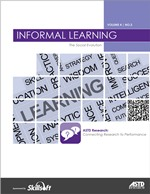ATD Blog
New Research: Informal Learning Recognized By Organizations, Not Yet Adopted As A Component of Learning & Development
Wed Jan 23 2013

The purpose of Informal Learning: The Social Evolution, conducted by ASTD and the Institute for Corporate Productivity (i4cp), is to examine the ways in which informal learning is evolving and how organizations are leveraging it to improve performance.
Some of the issues examined include:
• the current role of informal learning in the workplace
• investment in informal learning now and in the future
• the role of social networking technology in learning and development
• informal learning strategies and practices in use by organizations.
The ASTD/i4cp survey team defined informal learning as:
A learning activity that is not easily recognizable as formal training and performance support. Generally speaking, it takes place without a conventional instructor and is employee-controlled in terms of breadth, depth, and timing. It tends to be individualized, limited in scope, and utilized in small chunks. Examples of informal learning include online social networking, accessing knowledge through Internet or intranet searches, and peer-to-peer coaching. It does not include activities such as organized classes, workshops, and conventional job aids.
While the definition covers what informal learning is not, it’s important to consider that any sort of learning or acquisition of knowledge that is self-selected can be considered informal learning. The gaining or enhancement of knowledge that is undertaken by choice rather than direction, requirement, or mandate is, for our purposes, considered to be informal. This includes activities such as casually touching base with a colleague and inquiring about best practices before undertaking a new project, chatting with a mentor, exchanging instant messages with co-workers, or reading blog posts.
As Jay Cross, author and informal learning thought leader put it, “Informal learning is like riding a bike: the rider choses the destination, the speed, and the route.” Whereas “formal learning is like riding a bus: the driver decides where the bus is going; the passengers are along for the ride.”
Although many organizations recognize the potential of informal learning, most have yet to take steps to invest in or fully adopt it as a component of learning and development.
Analysis of the survey data and a review of the existing literature make clear several key findings:
• Nearly all the survey respondents (97 percent) reported that informal learning played a role in their learning initiatives within their organizations, with one-quarter reporting that it represented more than one-half of the total learning that occurred in their companies.
• Over 55 percent of respondents said their companies plan to increase their use of informal learning in the coming three years.
• Organizations with younger workforces are more likely to implement an informal learning program.
The complete report, Informal Learning: The Social Evolution is available on the ASTD Store.
